Abstract
With the increase in user density, it is a challenging problem to achieve higher energy efficiency in vehicle-to-everything (V2X) networks, where frequent handovers occur as users continuously pass through dense cell boundaries. In this paper, we investigate this energy efficiency problem in a highly dense V2X network. To alleviate inter-cell interference and reduce unnecessary handovers, we propose a user-centric network architecture and utilize the coordinated multiple point (CoMP) transmission scheme to enable multiple roadside access points (APs) simultaneously to service one mobile vehicle. Moreover, non-orthogonal multiple access (NOMA) is adopted to enable multiple users to multiplex within one sub-channel and improve system spectrum reuse. Accordingly, the energy efficiency optimization problem is formulated as system achievable rate per joule, with the constraints of the AP transmit power budget, vehicle minimum rate requirements, and the maximum number of CoMP APs serving each vehicle. To solve the optimization problem, a semi-dynamic CoMP AP clustering algorithm is proposed to select a group of CoMP APs to serve a vehicle user by considering the vehicle–AP channel coefficients and the vehicle user’s achievable energy efficiency. Then, with the selected CoMP AP clusters, a bidirectional selection algorithm is applied via NOMA to select multiple vehicle users multiplexing within one sub-channel and perform sub-channel power allocation. Numerical simulations are presented to verify the effectiveness of the proposed algorithms, and the results show the improvements offered by the proposed algorithms compared to current benchmarks.
1. Introduction
In terms of fifth generation mobile networks and beyond, the internet of vehicles (IoV), which can meet the developed requirements of intelligent transportation systems (ITSs), has been widely studied because of its huge potential in improving the safety and efficiency of transportation systems [1,2]. In vehicle communication, there are several different types of links, mainly including vehicle-to-vehicle communication (V2V), vehicle-to-pedestrian communication (V2P), and vehicle-to-infrastructure communication (V2I), which can be collectively referred to as vehicle-to-everything (V2X) [3]. Currently, there are two main V2X communication technologies, namely, dedicated short-range communication (DSRC) and a cellular-based vehicular network (C-V2X) [4]. Because of the limited coverage and low data rate of DSRC, recently, the developing C-V2X technologies have drawn attention from both academia and industry [5,6]. Since the announcement of Release 16, although 5G-NR V2X offers improved performance through investing more spectral and hardware resources, it is still challenging to meet the ever-increasing data rate requirements and connecting requests caused by diversified digital applications in autonomous vehicles vehicles [7].
1.1. Related Work
Owing to urbanization and technological advancements, it is anticipated that the number of mobile vehicles will grow rapidly. This will push the capacity limit of the existing communication system and pose challenges for the V2X system in terms of coverage, massive connecting requests, latency, and resource efficiency. To meet the requirement of massive and ubiquitous mobile-user access, non-orthogonal multiple access (NOMA) is regarded as a promising communication paradigm. In recent years, many studies have applied NOMA to V2X communication to improve the system performance, including low latency and ultra-high reliability [8,9]. For example, NOMA was introduced in [10] to support a low-latency IoV by its massive connectivity and fast random access. In [11], the carrier frequency offset (CFO) effect caused by high-speed vehicle movement had less impact on NOMA, which is another major technical advantage of NOMA technology applied to V2X networks. In [12], the authors studied NOMA based on spatial modulation (SM) to deal with the changeable channel environment in D2D communication and combined this with NOMA technology to improve the bandwidth efficiency of the system. In [13], the author proposed a decentralized V2X system based on NOMA and full duplex (FD) to meet the needs of vehicle quality of service under large-scale IoV quality of service (QoS) requirements. In [14], the authors combined NOMA with cognitive radio (CR) and applied it in the V2X environment, verifying the advantages of the CR-NOMA–assisted V2X system in two main metrics: downtime probability and bit error rate.
The energy efficiency (EE) problem for the V2X communication system has also received extensive attention [15,16,17,18,19,20]. In [15], the authors proposed an efficient relay-assisted transmission scheme based on V2X communication, maximizing the EE of the uplink while considering transmit power consumption, as well as the latency constraint. In [16], the authors proposed an energy-saving power allocation scheme using roadside cell (RSU)-assisted NOMA multicast, studying the EE maximization problem under the probability of vehicle power outage under the constraints of imperfect channel state information (CSI), QoS, and power limitation. In [17], the authors proposed a power allocation algorithm based on EE optimization for V2X communication networks based on cellular D2D. In [18], the authors designed a network model in which the RSU utilizes the wireless energy of radio frequency signals from electric vehicles for charging and information processing and utilizes the resource constraint characteristics of V2X for power allocation and resource block allocation to improve the energy efficiency of the overall network framework. In [19], the authors considered the energy-saving quota problem in cellular D2D-assisted V2X networks using NOMA, while meeting QoS requirements, through V2I links and V2V power allocation optimization on the link to maximize the minimum EE of each matching link. Furthermore, a static user-centric virtual cell was proposed to alleviate the frequent handover in [20]. In this work, a dynamic user-centric virtual cell scheme was proposed to solve a max–min-fair problem in the V2X system. In [21], a multiple-level platoon architecture, including the cloud, a roadside unit, and vehicles, was proposed to increase the communication coverage of a platoon and multiple platoons. In [22], a game theory–based resource allocation algorithm was proposed in 5G vehicular networks to improve the user transmission rate. Although the numerical results showed user rate enhancement achieved by the proposed algorithm, the authors did not consider that the higher algorithm complexity might be a drawback for the system’s latency performance.
1.2. Motivation and Contributions
To satisfy different mobile applications and achieve ubiquitous coverage, massive service nodes are densely deployed in the V2X system, shortening the transmission range from service node to vehicle greatly. In a highly dense V2X network, frequent handover occurs easily when vehicles continuously pass through the dense cell boundaries. Although the resource optimization problem has been well-discussed in V2X networks in the aforementioned works, all these works ignore the effect of increasing the density of service nodes on user scheduling and resource allocation. Furthermore, in [20,21,22], the resource allocation problems were discussed in highly dense V2X networks, while the system energy efficiency problem was ignored. Therefore, in this paper, we study an energy-efficient resource allocation in a NOMA-based V2X network, considering the effect of frequent handover and inter-cell interference on user scheduling and network resource allocation. The main contributions of this paper are as follows:
- Taking advantage of the high-density deployment of service nodes, a user-centric V2X network model is constructed, where one mobile vehicle is in the overlapping coverage of multiple access points (APs). To facilitate vehicle scheduling and increase the mobile vehicles’ throughput performance in the proposed network, a collaborative multipoint (CoMP) transmission method is adopted to enable a mobile vehicle to be served by multiple APs simultaneously.
- Aiming at improving the EE performance in the proposed network, an energy-efficient resource optimization problem is formulated. To solve this optimization problem, a NOMA-CoMP–based energy-efficient resource allocation scheme is proposed. In the proposed scheme, a semi-dynamic CoMP APs clustering algorithm is designed to select multiple CoMP APs to serve a vehicle according to the vehicle-AP link channel coefficient and the vehicle’s achievable energy efficiency.
The rest of this paper is organized as follows. In Section 2, we propose a user-centric V2X communication system mobile with NOMA-CoMP enabled and formulate a system energy efficiency optimization problem. The proposed NOMA-CoMP–based energy-efficient resource allocation scheme is proposed in Section 3, which includes a semi-dynamic CoMP APs clustering algorithm, an energy-efficient bisection NOMA users scheduling algorithm, and a DC programming–based power allocation. Numerical results are presented to verify the effectiveness of the proposed resource allocation scheme in Section 4. Finally, we draw the conclusions in Section 5.
2. System Model
As shown in Figure 1, a V2X communication system is established with NOMA-CoMP enabled in an urban traffic scenario, in which 2K mobile vehicle users () are randomly distributed. One communication-enabled traffic light can be regarded as a high-power access point (HPAP), while communication-enabled street lights are underlaid in the HPAP coverage as low-power access points () denoted as . The HPAP is used to handle the system control signaling, while the provide with data communication services. All and APs are equipped with a single antenna. In the proposed urban traffic scenario, vehicles run at a medium speed; so, the influence of the Doppler frequency shift can be ignored. The total system bandwidth is , which is divided equally into N orthogonal subchannels (SCs) with of each SC. Let represent the nth SC, where .
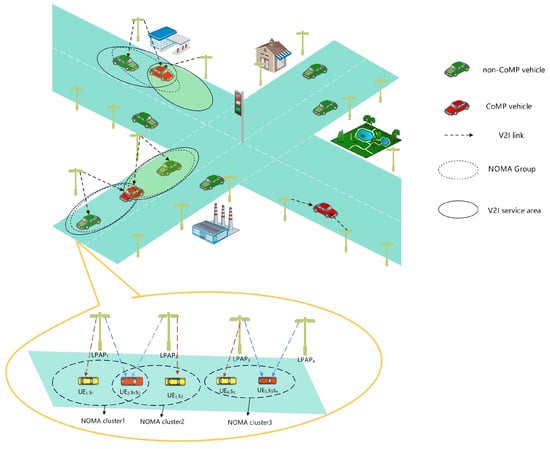
Figure 1.
System model of V2X network system that is NOMA-CoMP enabled.
In the proposed V2X communication scenario, the frequent handover occurs when UEs continuously pass dense LPAPs’ boundaries, which reduces the transmission performance of the LPAP edge UEs and increases the handover overhead. Suppose that a full UE’s channel gain coefficient can be obtained at all LPAPs. To reduce the frequent LPAPs’ handover overhead and increase the LPAP edge UEs’ QoS, UEs are classified into two groups, namely, CoMP users and non-CoMP users, by comparing the channel gain coefficient with a set threshold as a reference value. Those UEs with channel gain coefficient values lower than are identified as CoMP UEs, while the others belong to non-CoMP UEs, denoted as and , respectively. The is a cell edge user that is simultaneously served by multiple for a higher transmission rate. We define as a CoMP set, which is a group of collaborating that serve the kth CoMP user, where , , and . To further increase the spectrum reuse, the power-domain NOMA scheme is applied to the downlink transmission from to , including CoMP users and non-CoMP users, within its service area.
The desired signal of the CoMP served by the CoMP set can be expressed as
where denotes the desired signal of the kth UE and denotes the transmit power from to on .
The desired signal of the non-CoMP can be expressed as
The channel gain coefficient between the CoMP and on can be expressed as , where denotes the channel gain parameter with Rayleigh fading, , denotes the straight line distance between and , and is the path loss index. Then, is the channel gain coefficient between the non-CoMP and on . Let served by be assigned to with NOMA. Then, the total transmit power of on can be expressed as .
According to the NOMA scheme, interference from other users on the same SC can be removed via successive interference cancellation (SIC) at the receiver. We define the channel response normalized by the noise (CRNN) gain of on as . Since the principle of SIC is to gradually subtract the interference from users with a higher signal power at the receiver, the optimal decoding order for SIC is the increasing order of CRNNs. Then, a user with is decoded first if the CRNN on is ordered by , and then the rest of the other users’ signals are decoded in turn. Similarly, the CRNNs of non-CoMP on can be increasingly ordered by . According to the descriptions in system model, the CRNNs of non-CoMP UEs are larger than those of CoMP UEs, which can be represented as
To reduce the receiver complexity and ensure a low probability of error propagation, in this work, the number of NOMA users assigned to the same SC was set to two; thus, [11]. In [18], it was pointed out that clustering NOMA users with relatively distinct channel gain coefficient differences on the same SC enlarged the benefits of NOMA. Therefore, in the proposed network, a NOMA cluster is formed of a CoMP UE and a non-CoMP UE. Therefore, multiple LPAPs serve one CoMP UE, and at the same time, one CoMP UE can be formed in multiple NOMA clusters. For example, as shown in Figure 1, is served by and by CoMP and forms two different NOMA clusters with and , respectively.
The received signal of a CoMP can be expressed as
where denotes additive Gaussian white noise and is the variance. In Equation (4), the first item represents the desired signal received at CoMP , and the second item represents the co-channel interference from the other non-CoMP on transmitted by in .
Since all SCs are orthogonal to each other, a non-CoMP UE only suffers the co-channel interference from a CoMP in the same NOMA cluster. Thus, the received signal at a non-CoMP can be expressed as
According to Equation (5), through SIC, the received signal-to-interference-plus-noise ratio (SINR) at a non-CoMP can be expressed as
Based on Shannon’s capacity formula, the sum rate of the non-CoMP on can be expressed as:
Using the joint CoMP transmission mode, the CoMP is served by multiple LPAPs in a CoMP set collaboratively transmitted. In a practical scenario system, the implementation of NOMA clustering and CoMP is supported by signaling interaction between cooperative APs to share user channel state information, which causes large signaling overheads. To reduce these overheads, the number of collaborating APs is no more than three; that is, [23,24]. Thus, the SINR of a CoMP is expressed as
where item in Equation (8) denotes the NOMA multiplexing interference at CoMP .
So, the sum rate of CoMP can be expressed as
In this work, energy efficiency is utilized as the key metric, which is defined as the ratio of the transmission rate R to the signal transmit power (Watt), in bits per joule . Therefore, the energy efficiency of the non-CoMP on can be expressed as
For CoMP on , the energy efficiency can be expressed as
Therefore, the overall energy efficiency within a single CoMP set consists of a combination of CoMP users and non-CoMP users, denoted as
For the whole system, the overall system’s energy efficiency can be expressed as
Let be the number of CoMP LPAPs in for a . Thus, the energy efficiency optimization problem for the NOMA-CoMP network can be formulated as
where denotes the transmit power budget of an LPAP. denotes the minimum transmission rate requirement of the CoMP . indicates that the sum of the transmission power of CoMP users and non-CoMP users served by the same LPAP cannot exceed its transmit power budget. indicates that the served via the CoMP has a higher transmission gain than that transmitted by a single point. specifies that the number of a CoMP set cannot exceed three. guarantees that each LPAP can only serve one CoMP UE in one period.
3. Problem Optimization and Algorithm Design
In this section, we study the optimization problem (14) by considering CRNNs and the UE’s energy efficiency. It can be observed that the optimization problem in Equation (14) is nonconvex with respect to and since the object function is nonconvex. Thus, the global optimal solution cannot be easily obtained in polynomial time. To solve this problem efficiently, we decouple it into two subproblems, namely, an optimal user scheduling problem and a user power allocation problem. Firstly, we propose a CRNN-based user scheduling scheme by assuming equal power is allocated to each user. In this user scheduling scheme, a semi-dynamic CoMP LPAP clustering algorithm is proposed to form CoMP LPAP sets, while a bisection matching algorithm is applied to form a NOMA pair, consisting of a CoMP and a non-CoMP , to achieve further spectrum reuse. After that, a user power allocation algorithm within a is proposed to enhance the whole system’s energy efficiency with DC programming.
3.1. CRNN-Based User Scheduling Scheme
With given and , the origin optimization problem (14) can be reformulated as
By observing Equation (15), the user scheduling subproblem is a discrete nonlinear programming problem. To solve it, we propose a two-stage user scheduling scheme. Firstly, a semi-dynamic CoMP LPAP clustering algorithm is proposed to select a CoMP LPAP set for serving . Then, a NOMA group is formed for each CoMP by a non-CoMP UE that provides higher EE using an energy-efficient NOMA pair scheduling algorithm.
3.1.1. Semi-Dynamic CoMP LPAP Clustering Algorithm
The semi-dynamic CoMP LPAP clustering algorithm is proceeded by two-side selection between CoMP and LPAPs. When CoMP is in the overlap region of multiple LPAPs, the CoMP has a CRNN list recoding all these LPAPs who can provide service. The CRNN list is ordered from the one with the highest CRNN to the one with the lowest CRNN. In the first selection loop, a CoMP UE selects LPAPs from the top of the CRNN list and sends its accessing requests. Then, an LPAP receives the accessing request, selects the CoMP user among all the requests with the highest CRNN, and sends a successful access response. On the other hand, a CoMP receives responses and removes the CRNNs of the LPAP that did not send a successful response back. In the next loop, the CoMP , whose CoMP LPAPs number is less than , sends requests and awaits the successful access responses. The clustering algorithm is finished until , where l denotes the loop number. The detailed preclustering process is shown in Algorithm 1.
3.1.2. Energy-Efficient NOMA Pair Scheduling Algorithm
In this subsection, an energy-efficient NOMA pair scheduling algorithm is proposed to form NOMA pairs. Assume that each non-CoMP has an accessing priority list, denoted as
where is a matrix with I vectors and stores the indexes indicating the order of the ith LPAP transmit on . The index is a null vector if the ith LPAP is not able to serve . The main idea of this algorithm is that a non-CoMP UE sends an accessing request to the LPAP with the highest priority in their list. The LPAP calculates the energy efficiency value of this potential NOMA pair using Equation (12) and chooses the non-CoMP user who provides the highest energy efficiency value among all non-CoMP users who have sent accessing requests.
| Algorithm 1 Semi-dynamic CoMP LPAP clustering algorithm |
|
Let denote the set of a CoMP already assigned in Section 3.1.1 and denote the non-CoMP formed to the NOMA group served on in this subsection. denotes the unscheduled non-CoMP users. In each processing round, each non-CoMP user sends an accessing request to their favorite LPAPs served on according to the list. If is empty, directly put in it. If two or more non-CoMP users request one LPAP with , the non-CoMP user that can provide higher energy efficiency is accepted. The process is terminated if is empty. The detailed Algorithm 2 procedure is as follows:
| Algorithm 2 Energy-efficient bilateral selection NOMA scheduling algorithm |
|
3.2. Power Allocation Algorithm
With the NOMA pairing results in Section 3.1, the power allocation is performed on NOMA users within a to further improve the system’s energy efficiency. The original optimal problem can be rewritten as
Since the CoMP has a worse CRNN, it is decoded first. Denote as a power allocation factor, indicating the power allocated to two users at the ith LPAP on . Then, the transmit powers from ith LPAP to and on can be rewritten as and , respectively.
It can be observed that this problem (18) is nonconvex, and it can be solved via DC programming, where the objective function needs to be rewritten in the form of a difference of two convex functions. Then, the objection function of the problem (18) can be rewritten as follows:
Then, the problem (18) can be rewritten as
where
and and are continuous on its convex feasible set . The problem (20) can be solved by using DC programming [25,26,27], shown as Algorithm 3.
| Algorithm 3 DC programming-based power allocation algorithm |
|
4. Numerical Results
This section verifies the effectiveness of the proposed algorithms through Monte Carlo simulations. In this paper, a multilane urban road section scenario is considered, and the simulation parameters follow the 3GPP guidelines [28]. The main system simulation and channel models are described in Table 1 and Table 2, respectively. The signal light is located in the center as an HPAP, and the vehicles are dispersed according to the Poisson process.

Table 1.
Simulation parameters.

Table 2.
Channel model.
Figure 2 shows the achievable system energy efficiency versus the iterative times of the semi-dynamic CoMP LPAP clustering algorithm with different LPAP transmit power budgets. It can be observed that the proposed algorithm can quickly converge to a stable energy efficiency value. It can also be seen that the energy efficiency value with a higher transmit power budget significantly increases and surpasses the ones with a lower transmit power budget. After convergence, the energy efficiency value curve with W increases to the energy efficiency value curve with W and increases to the energy efficiency value curve with W, respectively, which indicates that with the increasing LPAP transmit power, the energy efficiency can be enhanced accordingly.
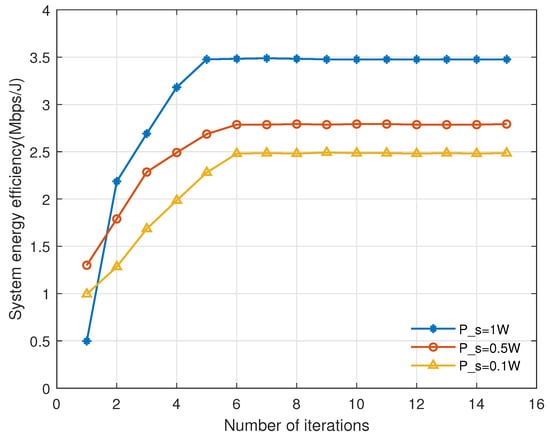
Figure 2.
Convergence diagram of the semi-dynamic LPAP clustering algorithm.
Additionally, Figure 3 shows the achievable system energy efficiency (Mbps/s) versus the transmit power of LPAP (W) with different transmission strategies, e.g., CoMP-NOMA with semi-dynamic clustering algorithm, CoMP-NOMA with random LPAP clustering, CoMP-OFDMA with semi-dynamic clustering algorithm, and CoMP-OFDMA with random LPAP clustering. In this case, the random CoMP clustering algorithm is regarded as a benchmark LPAP clustering algorithm in which the CoMP LAPAs set is randomly selected from all LPAPs for serving CoMP users. It can be seen in Figure 3 that the CoMP-NOMA scheme outperforms the other three schemes, which verifies the effectiveness of the proposed semi-dynamic LPAP clustering algorithm. Furthermore, more distinct energy efficiency enhancement can be obtained by the CoMP-NOMA scheme with the proposed user scheduling scheme because the LPAP clustering results impact the energy-efficient NOMA pairing results. Moreover, compared with the OFDMA system, the NOMA system can offer higher energy efficiency because higher spectrum reuse is achieved.
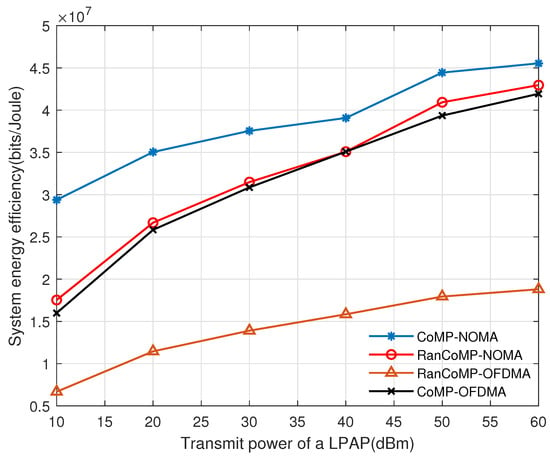
Figure 3.
Performance comparison of transmission strategies.
Figure 4 shows the system energy efficiency versus LPAP transmit power with and without CoMP enabled. It can be seen that the implementation of CoMP in the proposed system enhances the system’s energy efficiency compared to the system with a single-point transmission mode. Furthermore, it also shows that the system’s energy efficiency enhances slowly after the LPAP transmit power reaches 30 dBm because CoMP-enabled LPAPs should consume more transmit power to guarantee the QoS of edge user and obtain better system energy efficiency compared to the system with a single point.
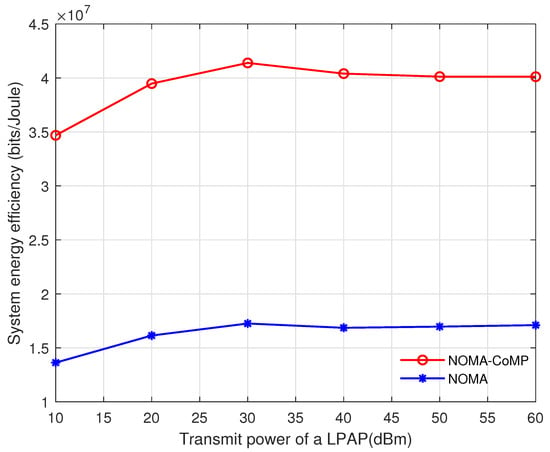
Figure 4.
Proposed scheme performance in different network models.
Figure 5 shows the system’s energy efficiency versus different LPAP transmit powers with different power allocation algorithms. The equal power allocation scheme is introduced as a benchmark. It can be seen in Figure 5 that the proposed power allocation with DC programming obtains better energy efficiency compared with the equal power allocation scheme. Furthermore, the system’s energy efficiency improvement is more distinct with lower LPAP transmit power, e.g., a 62.5% increase with 10 dBm, a 17% increase with 30 dBm, and a 10% increase with 10 dBm, because more system throughput requires more power consumption. In addition, compared to the OFDMA system, NOMA-CoMP with DC programming doubles the system’s energy efficiency optimization.
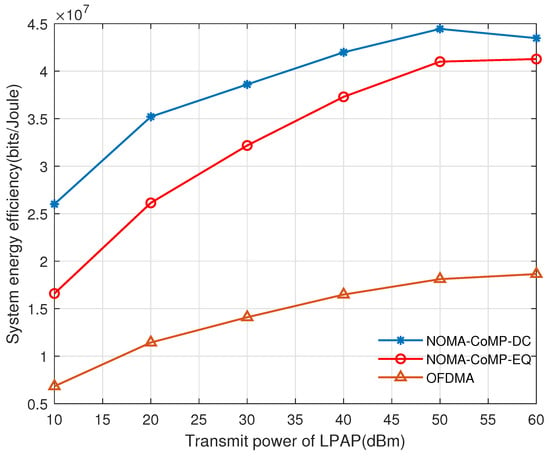
Figure 5.
The comparison of system energy efficiency with different power allocation algorithms.
Figure 6 shows the system’s energy efficiency versus the LPAP transmit power with different resource allocation schemes. Two resource allocation schemes are introduced as benchmarks, namely, the power allocation algorithm based on energy efficiency optimization (EEO) in [17] and the EE-based resource allocation for the V2I scenario in [19]. This shows that our proposed NOMA-CoMP-based energy-efficient (NCEE) resource allocation scheme outperforms the other two schemes with over 37% system energy efficiency improvement.
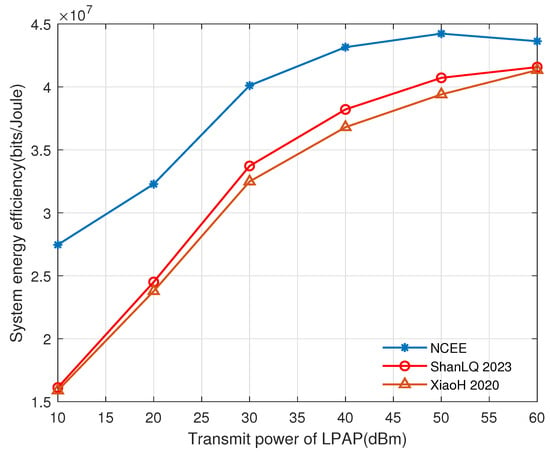
Figure 6.
The comparison of system energy efficiency with different resource allocation schemes [17,19].
5. Conclusions
Aiming at improving the system energy efficiency in a highly dense V2X network, this paper constructs a user-centric V2X network with NOMA-CoMP enabled. CoMP is used for multipoint cooperative transmission of a vehicle to reduce the system’s handover overhead caused by a vehicle continuously passing through dense LPAP boundaries. In addition, NOMA technology is used to boost spectrum reuse and further improve the system’s energy efficiency. Since the proposed energy efficiency optimization problem is an NP-hard problem, the original problem is decoupled into two subproblems, a CRNN-based user scheduling problem and a power allocation problem. Accordingly, an energy efficiency optimization scheme, including a semi-dynamic CoMP LPAP clustering algorithm, an energy-efficient NOMA pair scheduling algorithm, and a DC programming–based power allocation, is proposed to obtain the suboptimal solution of the original problem. The simulation results show that the semi-dynamic CoMP LPAP clustering algorithm has a low algorithm complexity and can achieve linear convergence in fewer iterative times, which can be a potential CoMP clustering algorithm for the latency-sensitive system. The simulation results also verify that the proposed energy efficiency optimization scheme designed in this paper has an over 37% system energy efficiency improvement compared to the existing energy efficiency optimization schemes.
Author Contributions
Conceptualization, W.X. and J.T.; methodology, W.X. and J.T.; formal analysis, W.X. and J.T.; investigation, W.X. and J.T.; resources, W.X.; data curation, J.T.; writing—original draft preparation, W.X. and J.T.; writing—review and editing, W.X. and J.T.; supervision, W.X.; funding acquisition, W.X. All authors have read and agreed to the published version of the manuscript.
Funding
This research was funded by the Shanghai Sailing Program, grant number 20YF1416700, Innovation Program of Shanghai Municipal Education Commission of China under Grant 2021-01-07-00-10-E00121, the National Natural Science Foundation of China (62271303).
Institutional Review Board Statement
Not applicable.
Informed Consent Statement
Not applicable.
Data Availability Statement
Data are contained within the article.
Conflicts of Interest
The authors declare no conflict of interest.
References
- You, X.; Wang, C.X.; Huang, J.; Gao, X.; Zhang, Z.; Wang, M.; Huang, Y.; Zhang, C.; Jiang, Y.; Wang, J. Towards 6G wireless communication networks: Vision, enabling technologies, and new paradigm shifts. Sci. China Inf. Sci. 2021, 64, 110301. [Google Scholar] [CrossRef]
- Aljeri, N.; Boukerche, A. Smart and Green Mobility Management for 5G-enabled Vehicular Networks. Trans. Emerg. Telecommun. Technol. 2020, 33, 1–18. [Google Scholar] [CrossRef]
- Guo, C.; Liang, L.; Li, G.Y. Resource Allocation for Low-Latency Vehicular Communications: An Effective Capacity Perspective. IEEE J. Sel. Areas Commun. 2019, 37, 905–917. [Google Scholar] [CrossRef]
- Duan, W.; Gu, J.; Wen, M.; Wen, M.; Zhang, G.; Ji, Y.; Mumtaz, S. Emerging Technologies for 5G-IoV Networks: Applications, Trends and Opportunities. IEEE Netw. 2020, 34, 283–289. [Google Scholar] [CrossRef]
- Shan, L.; Wang, M.M.; Zhang, F.; Chen, S.; Zhang, J. Resource allocation for cellular device-to-device-aided vehicle-to-everything networks with partial channel state information. Trans. Emerg. Telecommun. Technol. 2022, 33, 7. [Google Scholar] [CrossRef]
- Aslani, R.; Saberinia, E.; Rasti, M. Resource allocation for cellular V2X networks mode-3 with underlay approach in LTE-V standard. IEEE Trans. Veh. Technol. 2020, 69, 8601–8612. [Google Scholar] [CrossRef]
- Noor-A-Rahim, M.; Liu, Z.; Lee, H.; Lee, H.; Khyam, M.O.; He, J.; Pesch, D.; Moessner, K.; Saad, W.; Poor, H. 6G for vechicle-to-everthing (V2X) communications: Enabling technologies challenges, and opportunities. Proc. IEEE 2022, 110, 721–734. [Google Scholar] [CrossRef]
- Husain, S.; Kunz, A.; Prasad, A.; Pateromichelakis, E.; Samdanis, K. Ultra-High Reliable 5G V2X Communications. IEEE Commun. Stand. Mag. 2019, 3, 46–52. [Google Scholar] [CrossRef]
- Di, B.; Song, L.; Li, Y.; Han, Z. V2X Meets NOMA:Non-Orthogonal Multiple Access for 5G Enabled Vehicular Networks. IEEE Wirel. Commun. 2017, 24, 14–21. [Google Scholar] [CrossRef]
- Tanwar, S.; Tyagi, S.; Budhiraja, I.; Kumar, N. Tactile internet for autonomous vehicles: Latency and reliability analysis. IEEE Wirel. Commun. 2019, 26, 66–72. [Google Scholar] [CrossRef]
- Zhang, D.; Liu, Y.W.; Ding, Z.G.; Zhou, Z.; Nallanathan, A.; Sato, T. Performance Analysis of Non-Regenerative Massive-MIMO-NOMA Relay Systems for 5G. IEEE Wirel. Commun. 2017, 65, 4777–4790. [Google Scholar] [CrossRef]
- Chen, Y.; Wang, L.; Ai, Y.; Ai, Y.; Jiao, B.; Nalzo, L. Performance Analysis of NOMA-SM in Vehicle to Vehicle Massive MIMO Channels. IEEE J. Sel. Areas Commun. 2017, 35, 2653–2666. [Google Scholar] [CrossRef]
- Zhang, D.; Liu, Y.; Dai, L.; Bashir, A.K.; Nallanathan, A.; Shim, B. Performance Analysis of FD-NOMA-based Decentralized V2X Systems. IEEE Trans. Commun. 2019, 67, 5024–5039. [Google Scholar] [CrossRef]
- Le, C.B.; Do, D.T.; Zaharis, Z.D.; Mavromoustakis, C.X.; Mastorakis, G.; Markakis, E.K. System Performance Analysis in Cognitive Radio-Aided NOMA Network: An Application to Vehicle-to-Everything Communications. Wirel. Pers. Commun. 2021, 120, 1975–2000. [Google Scholar] [CrossRef]
- Zheng, C.; Feng, D.; Zhang, S.; Zhang, S.; Xia, X.-G. Energy Efficient V2X-Enabled Communications in Cellular Networks. IEEE Trans. Veh. Technol. 2019, 68, 554–564. [Google Scholar] [CrossRef]
- Ihsan, A.; Chen, W.; Zhang, S.Q.; Xu, S. Energy-Efficient NOMA Multicasting System for Beyond 5G Cellular V2X Communications With Imperfect CSI. IEEE Trans. Intell. Transp. Syst. 2021, 23, 10721–10735. [Google Scholar] [CrossRef]
- Xiao, H.; Zhu, D.; Chronopoulos, A.T. Power Allocation With Energy Efficiency Optimization in Cellular D2D-Based V2X Communication Network. IEEE Trans. Intell. Transp. Syst. 2020, 21, 4947–4957. [Google Scholar] [CrossRef]
- Jameel, F.; Khan, W.U.; Kumar., N.; Jantti, R. Efficient Power-Splitting and Resource Allocation for Cellular V2X Communications. IEEE Trans. Intell. Transp. Syst. 2021, 21, 3547–3556. [Google Scholar] [CrossRef]
- Shan, L.Q.; Gao, S.T.; Chen, S.S.; Xu, M.; Zhang, F.; Bao, X.; Chen, M. Energy-efficient resource allocation in NOMA-integrated V2X networks. Comput. Commun. 2023, 197, 23–33. [Google Scholar] [CrossRef]
- Xiao, H.; Zhang, X.; Chronopoulos, A.T.; Zhang, Z.; Liu, H.; Ouyang, S. Resource Management for Multi-User-Centric V2X Communication in Dynamic Virtual-Cell-Based Ultra-Dense Networks. IEEE Trans. Commun. 2020, 68, 6346–6358. [Google Scholar] [CrossRef]
- Gao, W.; Wu, C.; Zhong, L.; Yau, K.L.A. Communication Resources Management Based on Spectrum Sensing for Vehicle Platooning. IEEE Trans. Intell. Transp. Syst. 2023, 24, 2251–2264. [Google Scholar] [CrossRef]
- Zhou, Y.; Zhang, Y. User-centric data communication service strategy for 5G vehicular networks. IET Commun. 2021, 16, 1041–1056. [Google Scholar] [CrossRef]
- Sun, W.; Liu, J. 2-to-M coordinated multipoint-based uplink transmission in ultra-dense cellular networks. IEEE Trans. Wirel. Commun. 2018, 17, 8342–8356. [Google Scholar] [CrossRef]
- Pan, C.H.; Elkashlan, M.; Wang, J.Z.; Yuan, J.; Hanzo, L. User-centric C-RAN architecture for ultra-dense 5G networks:Challenges and methodologies. IEEE Commun. Mag. 2018, 56, 14–20. [Google Scholar] [CrossRef]
- Vucic, N.; Shi, S.; Schubert, M. DC programming approach for resource allocation in wireless networks. In Proceedings of the 8th International Symposium on Modeling and Optimization in Mobile, Ad Hoc, and Wireless Networks, Avignon, France, 31 May–4 June 2010; pp. 380–386. [Google Scholar]
- Boyd, S.; Vandenberghe, L. Convex Optimization; Cambridge University Press: Cambridge, UK, 2004. [Google Scholar]
- Nemirovskii, B.-T. Lectures on Modern Convex Optimization; Society for Industrial and Applied Mathematics: Cambridge, MA, USA, 2001. [Google Scholar]
- Tech University. 3rd Generation Partnership Project; Technical Specification Group Radio Access Network; Study on LTE Based V2X Services; (Release 14) 3GPP; Tech: Ruston, LO, USA, 2016. [Google Scholar]
Disclaimer/Publisher’s Note: The statements, opinions and data contained in all publications are solely those of the individual author(s) and contributor(s) and not of MDPI and/or the editor(s). MDPI and/or the editor(s) disclaim responsibility for any injury to people or property resulting from any ideas, methods, instructions or products referred to in the content. |
© 2023 by the authors. Licensee MDPI, Basel, Switzerland. This article is an open access article distributed under the terms and conditions of the Creative Commons Attribution (CC BY) license (https://creativecommons.org/licenses/by/4.0/).